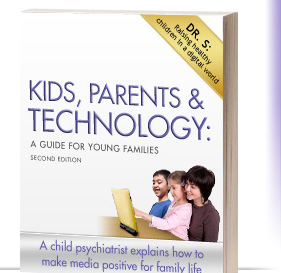Part 1: SETUP AND QUICK START GUIDE
Chapter 2: The Media Plan—Harvesting Growth Opportunities
from Media
We have an obesity epidemic in the US because too many children are left to themselves to follow unhealthy market-driven popular diets (see http://www.rwjf.org and http://www.healthinschools.org).
Like daily meals, it is imperative to set up regular family interactive media or online sessions. Innovative human interface devices like dance (http://en.wikipedia.org/wiki/Dance_pad,) exercise (http://www.nytimes.com/2008/05/15/fashion/15fitness.html?_r=1&th&emc=th,) mind control (http://www.nytimes.com/2008/06/08/technology/08novel.html?_r=1&ref=technology,) or musical technologies like a fine Internet-connected grand piano (http://www.nytimes.com/2008/04/17/technology/personaltech/17pogue.html,) and composing keyboard (http://www.nytimes.com/2008/07/10/technology/personaltech/10basics.html?_r=1&nl=tech&emc=techa1) provide great opportunities for hours of family fun and education.
For example, should we allow cell phones for a child eight years old? There certainly are advantages http://www.nytimes.com/2006/12/21/technology/21pogue.html?_r=1&scp=29&sq=children%20technology&st=cse and
http://www.nytimes.com/2009/10/13/health/13klas.html?_r=1&emc=tnt&tntemail1=y).
Having an overall Family Media Plan in place will make such decisions easier, especially when integrated into the cell phone itself (http://www.nytimes.com/2008/07/31/technology/personaltech/31smart.html?_r=1&nl=tech&emc=techa1).
Healthy, older children increasingly connect more intensely with peers using cell phones, online instant messaging, text messaging, and e-mailing. The impact of these practices on social and family relationships is receiving more thoughtful attention
(http://www.nytimes.com/2005/08/22/technology/22soft.html?_r=1&scp=22&sq=children%20technology&st=cseFirefoxHTML\Shell\Open\Command).
Some social networks that are public-service minded and partner with pro-social video games are becoming more and more community-oriented (http://bits.blogs.nytimes.com/2008/07/21/its-not-a-game-console-its-a-community/?ref=technology).
However, in older kids, the initial unqualified excitement about a computer for every child has become significantly tempered (http://www.slate.com/id/2192798 and related links.) While once widely used, fewer parents are actually using educational software today (http://www.nytimes.com/2005/08/22/technology/22soft.html?_r=1&scp=22&sq=children%20technology&st=cseFirefoxHTML\Shell\Open\Command).
Make use of storage devices like the Kindle or memory cards for PDAs and flash drives (http://pogue.blogs.nytimes.com/2006/07/08/08pogues-posts-3/?scp=32&sq=children+technology&st=cse) that make accessible lots of visual and auditory information otherwise available only in bulky books from libraries.
There are encouraging applications of video games in education (http://www.nytimes.com/2008/10/08/nyregion/08video.html?_r=1&nl=tech&emc=techa1).



